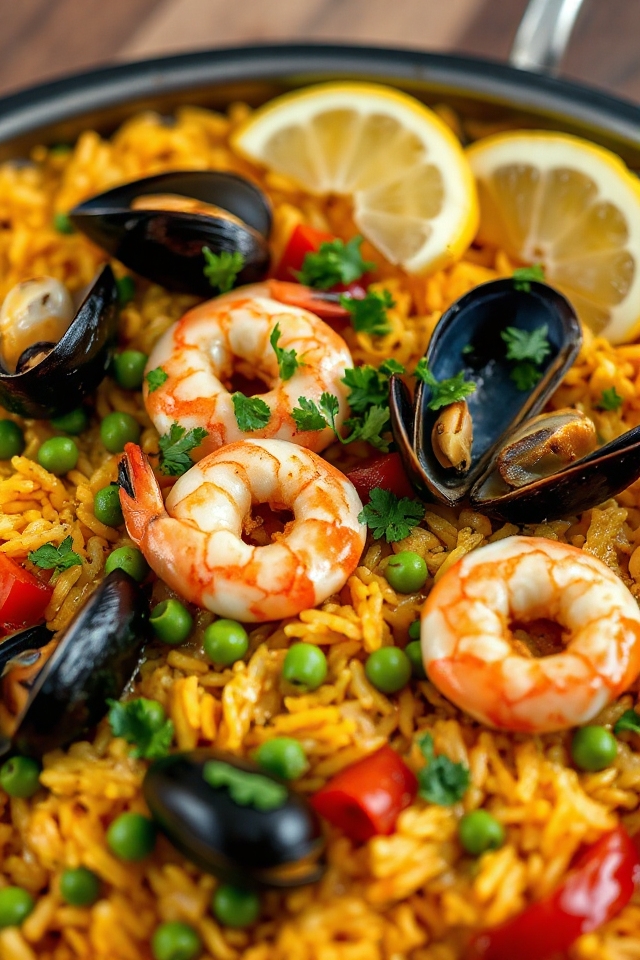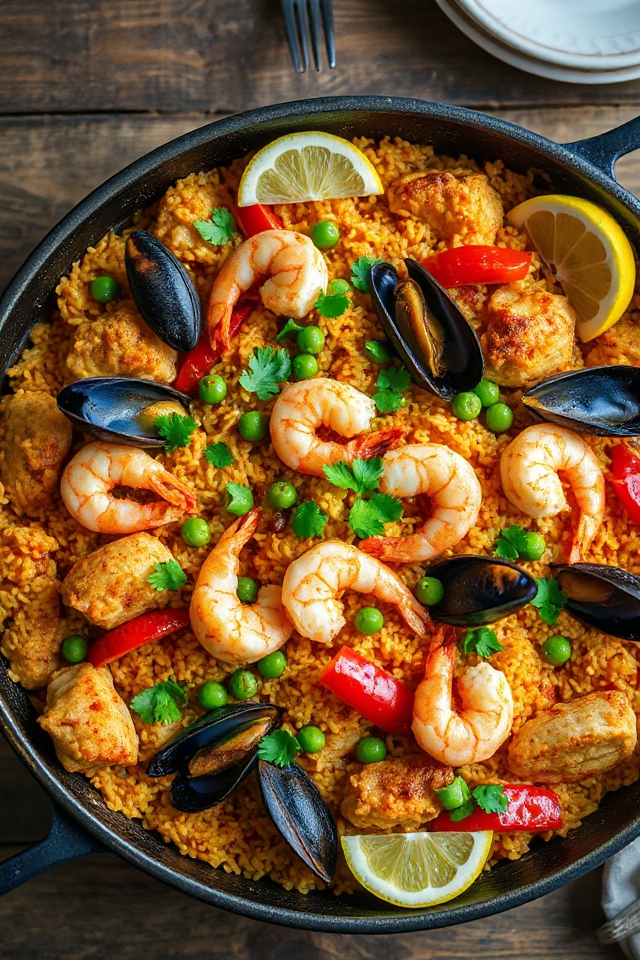Why You’ll Love This Spanish Paella Recipe
If you’ve ever tasted a well-made paella, you know it’s more than just a dish; it’s an experience.
I love how this vibrant meal brings together friends and family, creating unforgettable moments. The aroma of saffron and spices fills the air, drawing everyone to the table. Each bite bursts with flavor, showcasing the rich culinary tradition of Spain.
Plus, it’s incredibly versatile; whether you prefer seafood, chicken, or veggies, you can customize it to your taste.
Making paella is also a fun challenge, and I can’t wait to share this recipe so you can enjoy it too!
Ingredients of Spanish Paella
When it comes to crafting the perfect Spanish paella, the ingredients are what really make it sing. Think of them as the colorful characters in a vibrant story, each adding their own unique twist to the tale. From succulent seafood to tender chicken, and a medley of vegetables, each component plays a vital role in creating that unforgettable flavor profile.
Plus, the beautiful presentation of the dish is as important as the taste itself. So, let’s gather our ingredients and get ready for some serious culinary fun.
Ingredients for Spanish Paella:
- 2 cups of Bomba or Arborio rice
- 4 cups of chicken or seafood broth
- 1/2 teaspoon of saffron threads
- 1 pound of chicken pieces (thighs or drumsticks work great)
- 1 pound of shrimp, peeled and deveined
- 1 cup of mussels or clams, cleaned
- 1 cup of green peas (fresh or frozen)
- 1 red bell pepper, diced
- 1 onion, finely chopped
- 4 cloves of garlic, minced
- 1/2 cup of olive oil
- 1 tablespoon of smoked paprika
- Salt and pepper to taste
- Fresh parsley for garnish
- Lemon wedges for serving
Now, while you can absolutely stick to this list, feel free to mix things up a bit. Maybe you have some leftover chorizo lying around? Toss that in for a smoky kick.
Or perhaps you’re feeling adventurous and want to go all-vegetable? Swap in zucchini, artichokes, or whatever veggies you fancy. Just remember, the key to a great paella is balance—between the proteins, the rice, and those delightful spices.
And don’t be afraid to ask your local market for fresh seafood; it really elevates the dish and makes it feel like a special occasion. So, gather your ingredients, channel your inner chef, and let’s get ready to create something delicious.
How to Make Spanish Paella

Alright, let’s roll up our sleeves and plunge into making that beautiful Spanish paella. First things first, grab a large, wide pan—this is where the magic happens. It’s called a paellera, but if you don’t have one, any big skillet will do.
Heat up 1/2 cup of olive oil over medium heat. Once it’s nice and hot, toss in the 1 pound of chicken pieces. Sear them until they’re golden brown on all sides—about 5 to 7 minutes should do the trick. You want that lovely, crispy skin. Trust me, it’s going to add a depth of flavor that you won’t forget.
Now that your chicken is looking fabulous, go ahead and add in the 1 finely chopped onion and the 4 cloves of minced garlic. Cook these until the onion is soft and translucent, about 4 to 5 minutes. The aroma? Absolutely divine.
Next, it’s time for the star of the show: the rice. Add in 2 cups of Bomba or Arborio rice, stirring it around so it gets coated in that luscious oil. Sprinkle in 1 tablespoon of smoked paprika and 1/2 teaspoon of saffron threads—this is where the color and flavor start to build.
Now, pour in 4 cups of chicken or seafood broth, and season with a bit of salt and pepper. Bring it to a gentle simmer.
After that, it’s time for the fun part—let’s add in the seafood. Gently place 1 pound of shrimp, along with 1 cup of mussels or clams into the pan. Don’t forget about the 1 cup of green peas and the diced 1 red bell pepper; they’ll add a pop of color and sweetness.
Let everything simmer together for about 15 to 20 minutes, or until the rice is cooked and has absorbed most of the liquid. If the rice starts to look a little dry, don’t panic—just add a splash more broth.
Once it’s done, let it rest for about 5 minutes. Garnish with fresh parsley and serve with lemon wedges. Ah, the moment of truth; you’ll be amazed at how something so simple can taste so extraordinary. It might even make you consider hosting a dinner party—just don’t forget to invite me.
Spanish Paella Substitutions & Variations
While traditional Spanish paella is a culinary delight, there’s plenty of room for creativity with substitutions and variations that can cater to different tastes and dietary preferences.
For a vegetarian twist, I love swapping out seafood and meat for seasonal vegetables and chickpeas. If you’re craving something lighter, consider using cauliflower rice instead of traditional rice.
You can also experiment with different proteins—chicken, shrimp, or even tofu work beautifully. Don’t forget about spices! Adding saffron or smoked paprika can elevate the dish.
Personalize your paella to make it uniquely yours while still celebrating its rich flavors and textures.
What to Serve with Spanish Paella
To enhance your Spanish paella experience, consider pairing it with a variety of side dishes and accompaniments that complement its rich flavors.
I love serving a fresh green salad with a tangy vinaigrette; it adds an invigorating crunch. Sliced crusty bread works wonders for soaking up those delicious juices. You might also enjoy a simple garlic aioli for dipping.
If you want a bit of zest, a side of roasted vegetables can elevate the meal. Finally, don’t forget a glass of sangria or a crisp white wine to wash it all down.
It truly makes for a delightful dining experience!
Additional Tips & Notes
When enjoying your Spanish paella with those delightful sides, remember a few additional tips to elevate your dish.
First, let the paella rest for about five minutes after cooking; this allows the flavors to meld beautifully.
Don’t skip the saffron—it’s essential for that authentic taste and vibrant color. If you can, use a traditional paella pan for even cooking.
Finally, I love to serve it with a wedge of lemon; the acidity brightens everything.
Experiment with different proteins or veggies, but don’t overcrowd the pan. Trust me, these small tweaks make a big difference in your paella experience!
